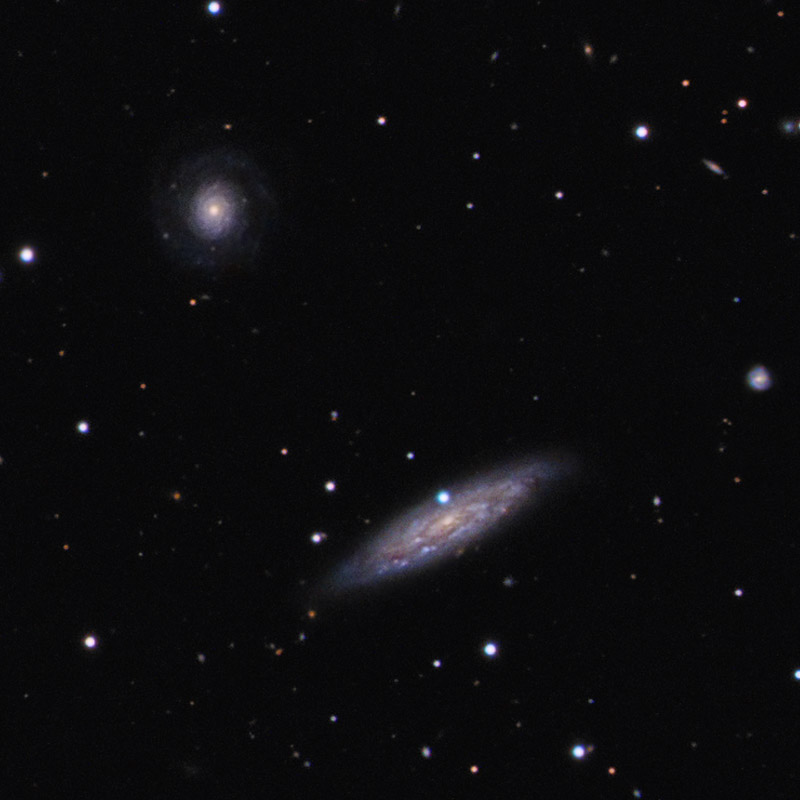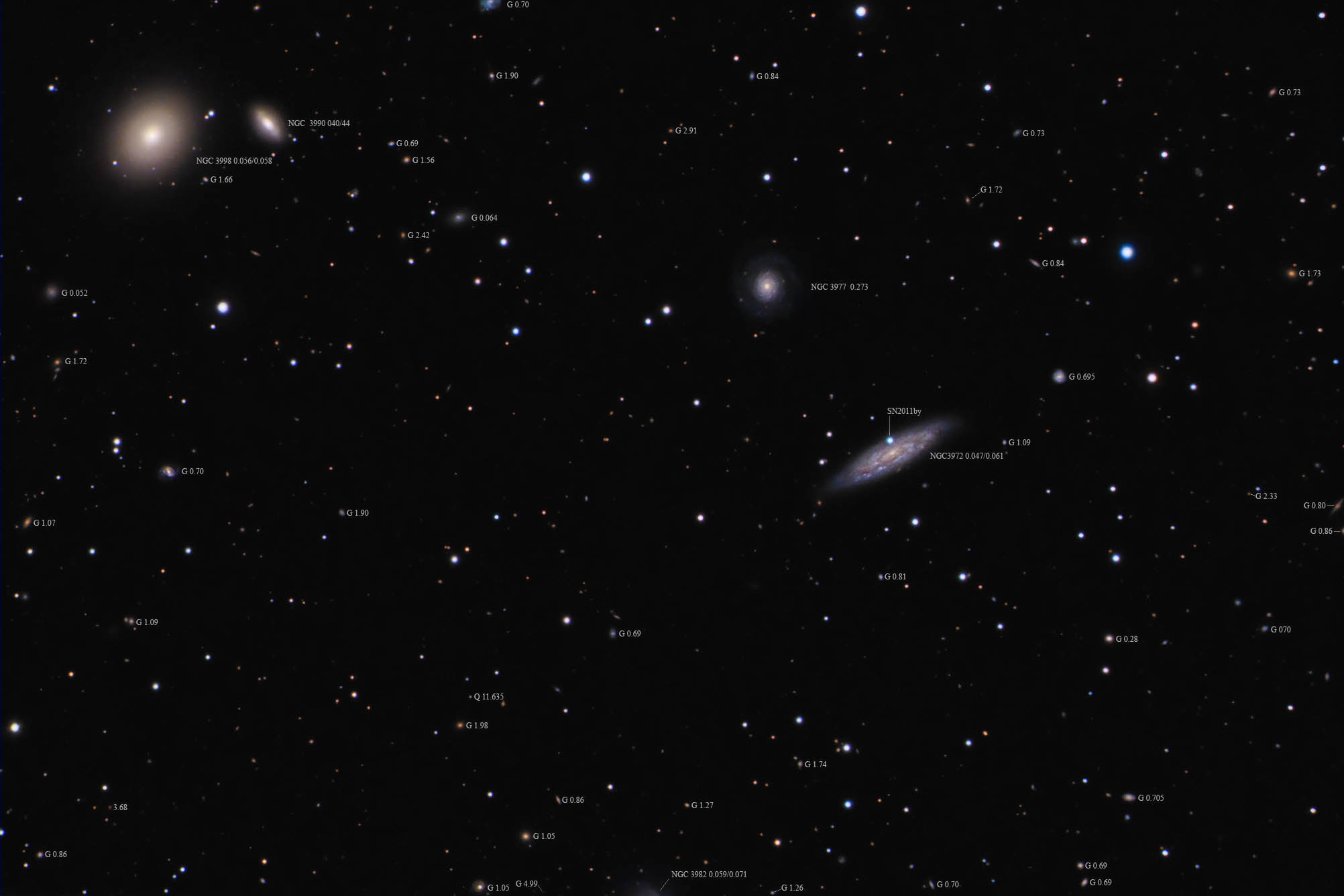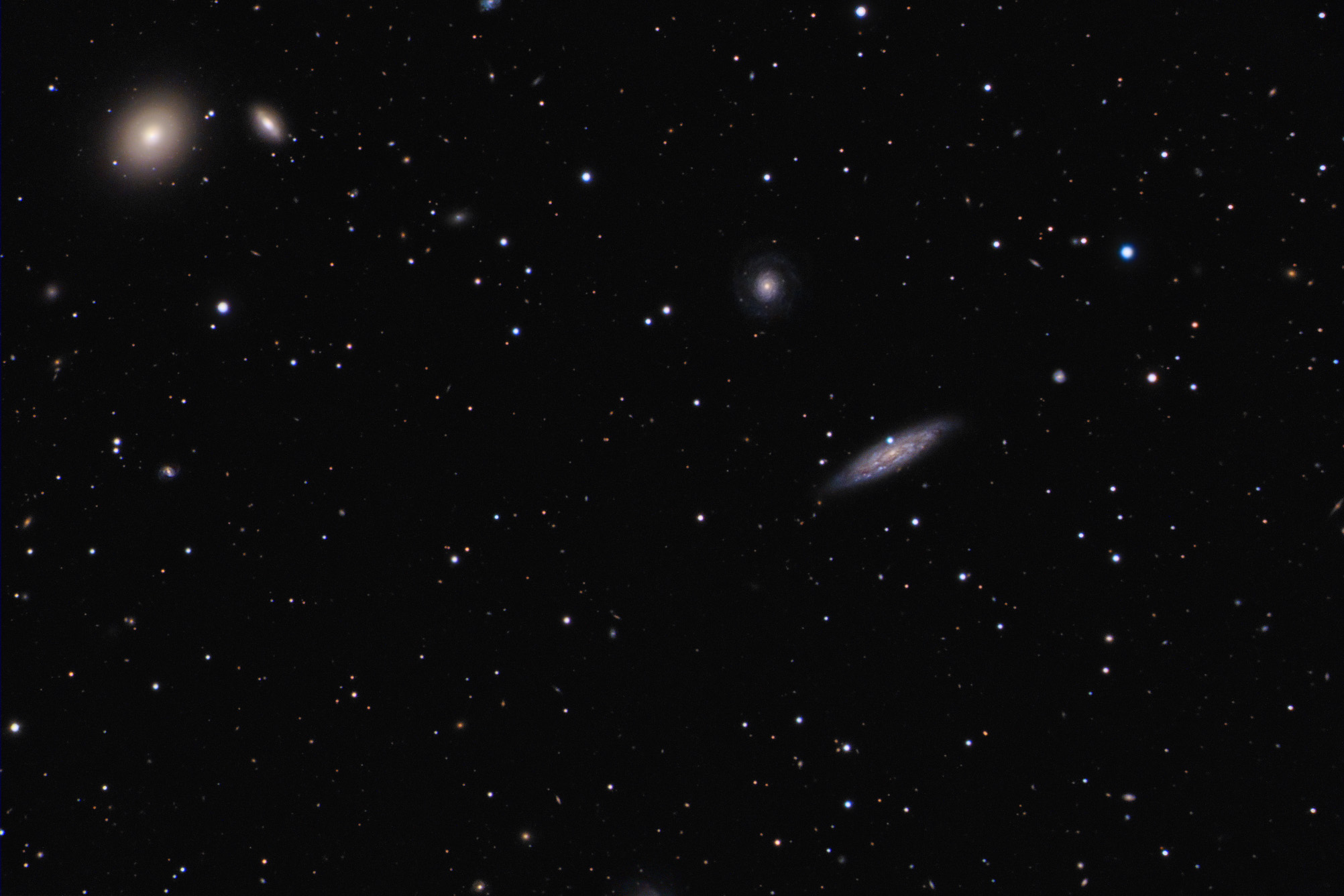| Description | Images |
Object name: NGC3972Designation(s): NGC3972, SN2011by, NGC3977, NGC3990, NGC3998, SN2011by was discovered by Zhangwei Jin and Xing Gao (China) on 2011/04/26.823. It is in the Ursa Major Galaxy NGC 3972. My awful spring weather prohibited my imaging it until almost exactly a month later on May 26.193 UT. It is a type 1A supernova. These are used a "standard candles" to measure distances to galaxies. In fact, they are responsible for the discovery of "dark energy" that is now causing the expansion of the universe to speed up at an ever increasing rate as its density decreases. To be used for this purpose we must know the distances to nearby galaxies by other means. NED publishes both a redshift determined distance and one by other means. Tully-Fisher in the case of NGC 3972 which is based on the rotational speed of spiral galaxies. I show both distance measurements in the annotated image. Note they are not in good agreement. This may be a case of the supernova improving the distance measurement to a nearby galaxy. I suspect it will have Hubble looking for Cepheid variables in the galaxy to better pin down its distance. Several other NGC galaxies are in the image. The two in the upper left corner have a secondary distance measurement as well but not being spirals it is different. In this case, it is SBF which stands for Surface Brightness Fluctuations. This is based on the idea that the more distant a galaxy of this type the less we can resolve the granular nature of partially resolved stars. The more even the brightness at high resolution the more distant the galaxy. In this case, the two measurements are in good agreement. Related Designation(s):1AXG J115757+5527, 1ES 1155+557, 1RXS J115756.1+552717, 1XMM J115756.2+552711, 2MASS J11554508+5519142, 2MASS J11573556+5527311, 2MASS J11575612+5527128, 2MASX J11554511+5519144, 2MASX J11560714+5523263, 2MASX J11573559+5527318, 2MASX J11575616+5527128, 2MFGC 09363, 2PBC J1158.1+5527, 2XMM J115756.1+552714, 2XMMp J115756.1+552714, 6C B115520.5+554340, 87GB 115323.7+553508, 87GB 115521.8+554353, 87GB[BWE91] 1153+5534, 87GB[BWE91] 1155+5543, ASK 238996.0, CGCG 1153.1+5535, CGCG 1153.5+5540, CGCG 1155.0+5543, CGCG 1155.3+5543, CGCG 269-016, CGCG 269-017, CGCG 269-024, CGCG 269-025, CGRaBS J1157+5527, CRATES J1157+5527, CRATES J115756.13+552712.9, CXO J115756.1+552713, CXO J115756.11+552713.1, GB6 J1157+5527, HDCE 0706 NED015, HDCE 0706 NED019, HDCE 0706 NED021, HOLM 304A, HOLM 304B, HOLM 310A, HOLM 310B, IRAS 11531+5535, IRAS F11531+5535, IRAS F11553+5543, LDCE 0846 NED003, LDCE 0867 NED049, LDCE 0867 NED053, LDCE 0867 NED055, LGG 241:[G93] 006, LGG 241:[G93] 007, LQAC 179+055 007, MAPS-NGP O_131_0049535, MCG +09-20-032, MCG +09-20-034, MCG +09-20-043, MCG +09-20-046, NGC 3972, NGC 3972:SN 2011by, NGC 3977, NGC 3980, NGC 3990, NGC 3998, NGC 3998:[L2011a] X0001, NGC 3998:[LB2005] X01, NGC 3998:[R97] 09, NGC 3998:[RW2000] X-02, NGC3972, NGC3977, NGC3990, NGC3998, NSA 041561, NSA 041674, NSA 140497, NSA 140507, NVSS J115756+552712, PGC 037466, PGC 037497, PGC 037618, PGC 037642, PSN J11554551+5519320, PSN J11554556+5519338, RBS 1053, RGB J1157+554, RX J1157.9+5527, RX J1157.9+5527:[BEV98] 001, RX J1157.9+5527:[ZEH2003] 01 , SDSS J115545.08+551914.6, SDSS J115545.09+551914.7, SDSS J115607.19+552326.9, SDSS J115607.20+552326.8, SDSS J115735.57+552731.6, SN 2011by, SN2011by, SSTSL2 J115735.51+552731.3, SSTSL2 J115756.11+552712.8, SWIFT J1157.8+5529, SWIFT J1158.0+5526, UGC 06904, UGC 06909, UGC 06938, UGC 06946, UMa Cluster:[PRL2014] U071, UMa Cluster:[PRL2014] U081, UMa Cluster:[PRL2014] U084, UNAM-KIAS 0824, UZC J115545.2+551913, UZC J115607.2+552326, UZC J115735.6+552731, UZC J115756.2+552713, v2MCG 47:[DMP2012] 1, v2MCG 47:[DMP2012] 3, v2MCG 47:[DMP2012] 4, VIPS 0499, VIPS J11579+5527, XSS J11570+5514, [AHG2014] B165, [GMM2009b] 32, [HRT2007] J115757+552713, [M98j] 170 NED19, [M98j] 170 NED25, [M98j] 170 NED27, [MGD2014] 1155.3+5543, [SRM2005] J115756.13+552712.9 , [TTL2012] 237936, [VCV2001] J115756.1+552713, [VCV2006] J115756.1+552713, [WB92] 1154+5537 NED01, [WB92] 1155+5543, |
Permanent link: https://images.mantrapskies.com/catalog/NGC/NGC3972-SN2011by-NGC3977-NGC3990-NGC3998/NGC3972L4X10RGB2X10-CROP125.jpg |


